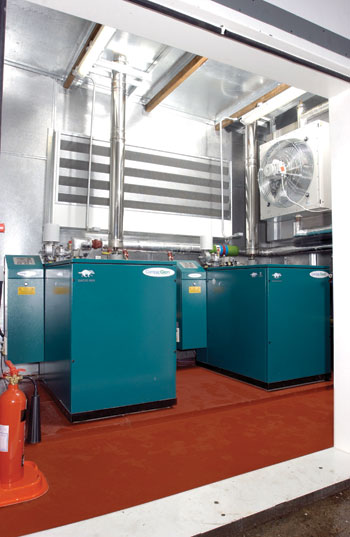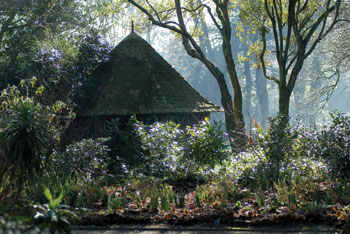Rising energy prices and the need for convenient retrofit solutions to help buildings meet the requirements of the revised Part L of the Building Regulations are driving up demand for combined heat and power (CHP) in the UK.
Discerning owners are also creating a fashion for microgeneration as they seek to prove their green credentials. CHP could well become the new must-have purchase for aspirational home owners looking to invest in their properties and reduce their carbon footprint.
Britain has lagged behind many other European countries in the uptake of co-generation technologies. But this irresistible combination of the pragmatic and the fashionable is finally stoking our market.
CHP was always an attractive option for applications with high heating loads, but it is proving even more popular now because it can be adapted to complement conventional boiler plant without a need to reconfigure existing pipework and internal heat emitters.
It is a convenient and cost-effective way of improving your carbon footprint without the major expenditure and upheaval required to integrate renewables.
CHP is the simultaneous generation of usable heat and power (usually electricity) in a single process. It can be employed over a wide range of sizes, applications, fuels and technologies. The engine at the heart of the unit drives a generator to produce three-phase electricity.
The principle is similar to a car in many ways. While driving the generator, the engine produces heat, which is captured from its cooling system and diverted to provide space and water heating in a building.
The engines are designed to be robust and reliable, so will run for thousands of hours, delivering up to 450MWh of electricity and 1,200MW of usable heat.
Some or all of the electricity can be used on site and any surplus fed back into the grid via the building's electrical distribution panel.
In a number of applications, the CHP unit can be used as the lead boiler in a modular set-up with heating-only equipment as back-up and only used sparingly.
On-site microgeneration is widely regarded as the UK's best opportunity to reduce carbon emissions in line with the tough goals we have been set since Kyoto.
Currently, we derive more than 90% of our energy from gas-fired power stations, which waste more than 65% of the energy they produce in rejected heat and transmission losses. At a time when the UK has become a net importer of natural gas, this is a criminal waste of an increasingly finite and precious resource.
'We are literally throwing away over two thirds of the energy we produce,' says Mike Malina, energy expert at M&E Sustainability. 'Just 32% of the energy produced by central power stations actually ends up as usable power - the rest is lost.
'These losses mean large central generation strategies are doomed to failure - and that includes the new generation of nuclear stations planned by the government. We must move towards a distributed energy strategy with most of our energy generated closer to the point of use by microgeneration systems if we are to have any chance of meeting our carbon reduction targets.
'CHP is an ideal solution as it is relatively easy to adopt, is extremely flexible and can solve an end user's power and heating needs at a stroke,' adds Malina.
Rather than throwing away the heat produced by the electricity generation process, a CHP unit like Baxi-SenerTec's Dachs SE, for example, can provide between 12.5kW and 15kW of heat output, while simultaneously producing 5.5kW of electricity at an overall efficiency of up to 92%.

Installed: BaxiSenerTec Dachs mini CHP units
With central power stations operating at around 35% efficiency and conventional heating at around 80%, at best you are looking at an overall efficiency for modern, well maintained conventional systems of just 60%.
In other words, two thirds of your electricity bill is paying for heat that is thrown away up the cooling towers of power stations. With CHP, the heat is not thrown away, it is turned into valuable heating and you get the electricity very cheaply. At a time when electricity costs are rising steadily, being able to produce your own and keep your costs transparent is proving increasingly attractive.
The latest CHP models are also designed to reduce installation and commissioning time because they are delivered to site as complete packages. For example, the Dachs SE comes complete with a buffer vessel and all heating system components including an integrated control unit.
Buildings with high heating and energy demand are ideal for CHP. Leisure centres and swimming pools, hotels, hospitals, sheltered housing, fire stations, schools and many others with either long running hours or periods of intense demand will keep the CHP unit working almost continuously.
This is when CHP is at its most efficient because the engine is producing electricity all
the time that it is running. The buffer tank will absorb and store excess heat for release into the heating system when required, and importantly reduces the frequency of on/off cycling that can be so damaging to engines.
The CHP unit can be easily integrated with existing services and controlled via an integral controls module that monitors the condition of the system and ensures optimum operating efficiencies. CHP systems can also form the heart of a trigeneration system which will provide cooling as well as heating thanks to the addition of a chiller.
SenerTec has also developed a G83-compatible connection interface for the Dachs unit to ease the process of transmitting electricity back to the grid. It also has a condensing option to drive up thermal efficiencies.
The government has had a long-term target for doubling CHP capacity in the country to 10,000MW by 2010. But, until the revisions to Part L, there were no practical regulatory instruments for supporting this aim and no grants were available because CHP is not a renewable. So, despite its proven high efficiency, the technology has had to stand on its own two feet.
Yet, the government's own statistics show that every megawatt of CHP operating in the UK helps reduce carbon emissions by between 510 and 760 tonnes every year. That means the existing 5,792MW installed, provided by about 1,500 sites across the UK, is already reducing the country's carbon emissions by more than 4M tonnes a year.
There are some fiscal incentives available to encourage wider take-up of CHP. For example, the fuel used to power good quality CHP and the electricity produced is exempt from the Climate Change Levy, and purchases of CHP systems will qualify for Enhanced Capital Allowances. They also attract a lower rate of VAT.
The EU Cogeneration Directive aims to double the amount of electricity generated by CHP to 18% of the total market by 2010 through a series of incentives and promotional measures. This would cut Europe's carbon emissions by 65M tonnes a year.
Energy watchdog Ofgem has also ensured that small electricity generators should now receive a fair price for the electricity they sell back to the grid under the latest revisions to the New Electricity Trading Arrangements.
Previously, this has proved a major stumbling block to the uptake of micro-generation as major utilities did not make it easy or economically attractive for small generators to sell their electricity. But energy minister Malcolm Wicks has committed to a new system of feed-in tariffs, which will be the subject of a major consultation later this year.
The government has undertaken for its own departments to receive 15% of their energy from CHP-generated electricity; and will encourage other parts of the public sector to adopt similar targets.
The UK still remains a long way behind many of our European partners in the uptake of microgeneration technologies. In Germany, for example, CHP is a common sight and SenerTec alone has sold more than 17,000 units - there is even an owners club for CHP enthusiasts.
It would be surprising if that level of enthusiasm were to be replicated here, but the tide has definitely turned. Sales of the Dachs unit have trebled in just over a year in the UK, admittedly starting from a low base. The combination of rising energy costs, growing awareness of the need to reduce carbon emissions and legislation that is now starting to bite is creating an irresistible momentum for change.
· M&E Sustainability is a joint campaign created by the HVCA and its sister trade body the Electrical Contractors' Association to promote the uptake of sustainable design across the mechanical and electrical contracting sector.
David Shaw is business manager of Baxi-SenerTec UK.
Visit www.baxi-senertec.co.uk

Trelissick Gardens, Cornwall, usees LPG-powered Dachs units